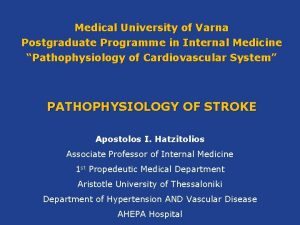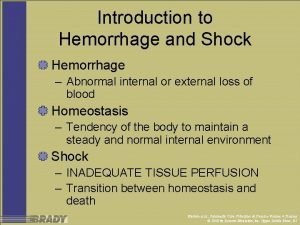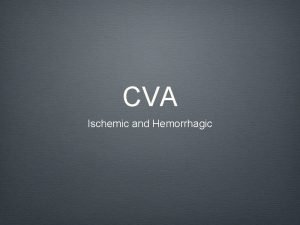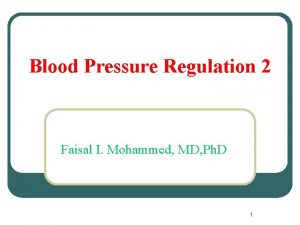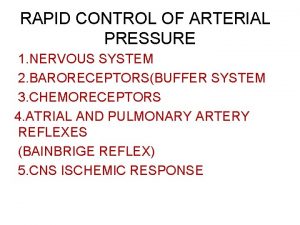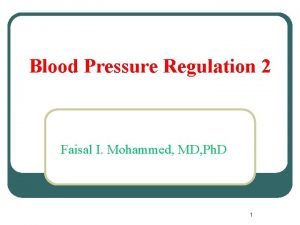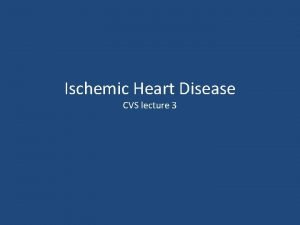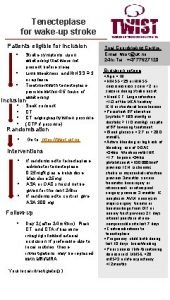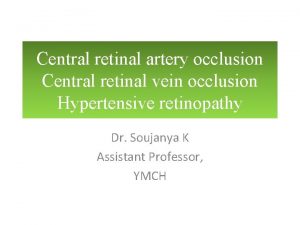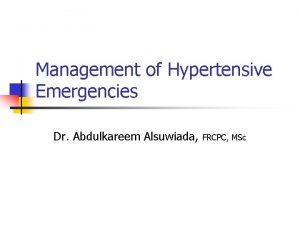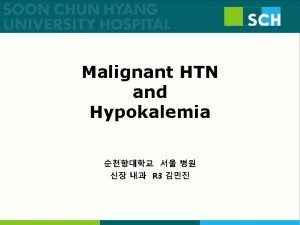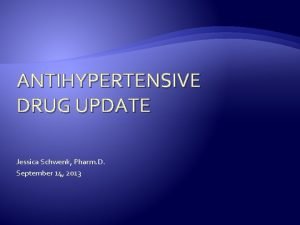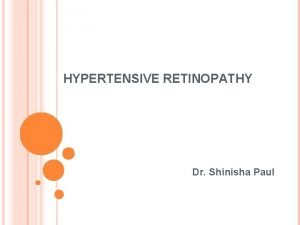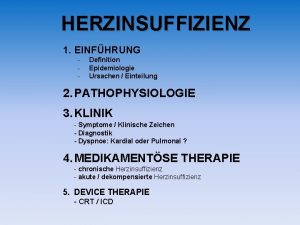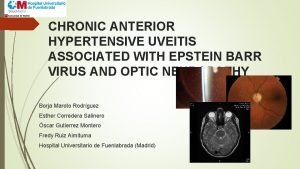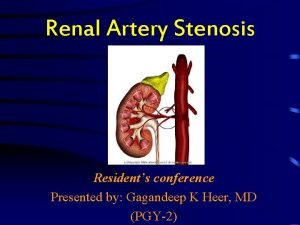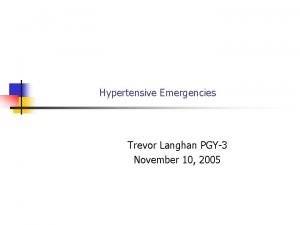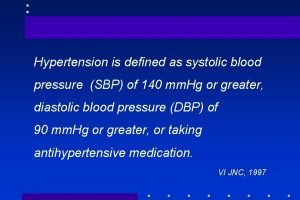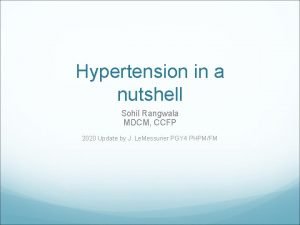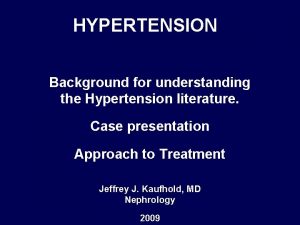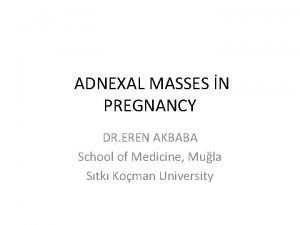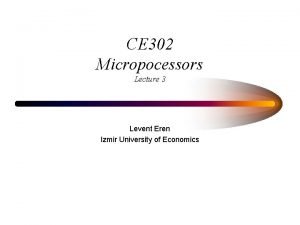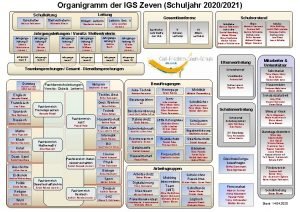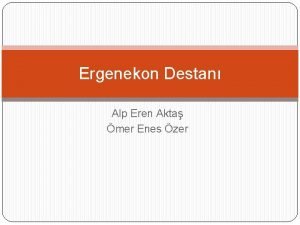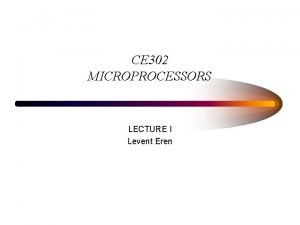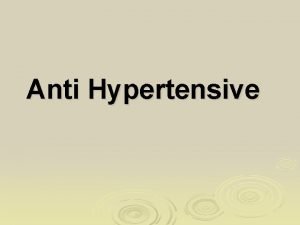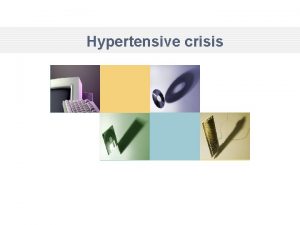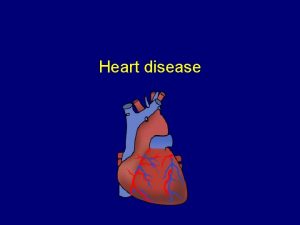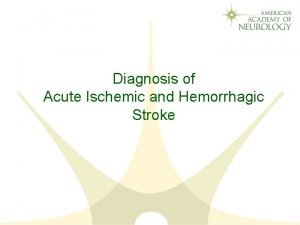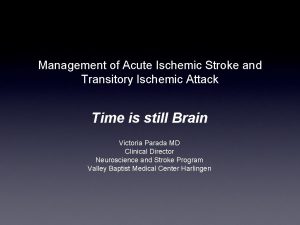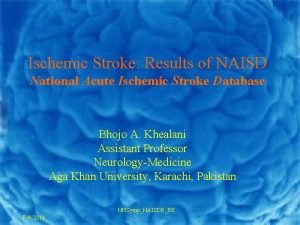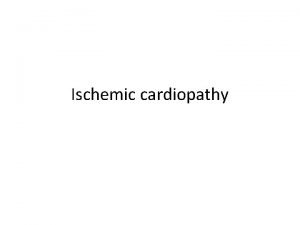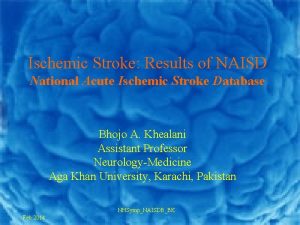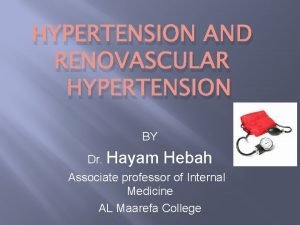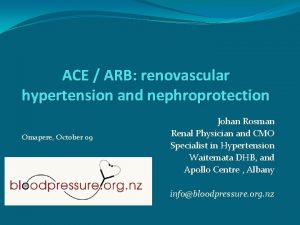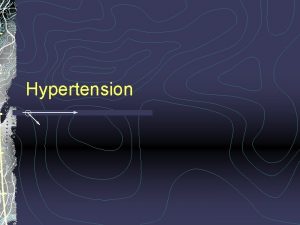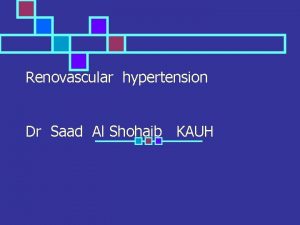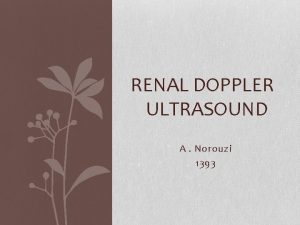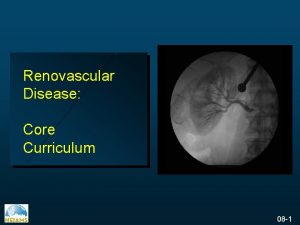Hypertensive and ischemic nephropaties renovascular diseases Zehra Eren


























































- Slides: 58

Hypertensive and ischemic nephropaties, renovascular diseases Zehra Eren, M. D.

LEARNING OBJECTIVES • explain hypertansion and renal disease interaction, • describe renovascular diseases • describe diagnostic evaluation • explan therapy in renovascular deseases • describe and manage renal artery and vein thrombosis • explain microvascular renal diseases

Hypertension and renal disease


Clinical manifestations of renovascular disease Asemptomatic ‘’İncidental Renal Artery Stenosis’’ Renovascular Hypertension İschemic Nephropathy Accelerated CV Disease -Congestive heart failure -Stroke -Secondary aldosteronism

Clinical manifestations of renovascular disease Asemptomatic ‘’İncidental Renal Artery Stenosis (RAS)’’ Renovascular Hypertension İschemic Nephropathy Accelerated CV Disease -Congestive heart failure -Stroke -Secondary aldosteronism

Asemptomatic ‘’İncidental Renal Artery Stenosis’’ Some degree of RAS can be identified in 20%45% of patients undergoing vascular imaging Most of these stenoses are of little or no hemodynamic significance

Clinical manifestations of renovascular disease Asemptomatic ‘’İncidental Renal Artery Stenosis (RAS)’’ Renovascular Hypertension İschemic Nephropathy Accelerated CV Disease -Congestive heart failure -Stroke -Secondary aldosteronism

Pathogenesis

Renovascular Hypertension Reduced renal perfusion Rise in arterial pressure Diagnosis is established only in retrospect after succesful reversal of HT with revascularization

Lesions producing renovascular hypertension

Fibromuscular Disease 3%-5%, Medial F>M fibroplasia is the most common Location: Smoking midportion of the vessel is a risk factor for progression

FMD

Atherosclerosis Most common renovascular lesion (75% - 84%) Location: origin of artery Associated with HT, DM, HPL, smoking, abnormal renal function


Bilateral RAS



Changes of renin-angiotensin system in renovascular hypertension



Clinical features

Clinical syndromes

Disease progression in atherosclerotic renal artery stenosis

Clinical manifestations of renovascular disease Asemptomatic ‘’İncidental Renal Artery Stenosis’’ Renovascular Hypertension İschemic Nephropathy Accelerated CV Disease -Congestive heart failure -Stroke -Secondary aldosteronism

Pathophysiology of ischemic renal disease


Goals of Diagnostic Evaluation Establish presence of RAS: location and type of lesion Establish whether unilateral or bilateral stenosis (or stenosis to a solitary kidney) Establish presence and function of stenotic and nonstenotic kidneys Establish hemodynamic severity of renal arteral disease Plan vascular intervention

Diagnostic Testing for Renovascular Hypertension and İschemic Nephropathy Physiologic and functional studies of the Renin-Angiotensin system -plasma renin levels -measurement of renal vein renin levels Noninvasive imaging and assesment of the renal vasculature -Doppler USG -radyonuclide imaging -magnetic resonance arteriography -computed tomographic angiography


Doppler ultrasonography


Gadolinium-enhanced magnetic resonance (MR) angiography

Computed tomography angiogram

Angiography


Goals of Therapy Improved Prevent BP morbidity and mortality Preservation of renal function

Therapy Medical Surgical therapy -angioplasty and stent replacement


Serum creatinine and blood pressure levels before and after percutaneous renal artery angioplasty (PTRA)

Clinical Factors Favoring Medical Therapy and Revascularization or Surveillance for Renal Artery Stenosis

Disorders of Renal Arteries and Veins

Causes of renal artery thrombosis

Symptoms of renal artery occlusion

Peripheral manifestations of atheroembolic disease

Acute focal infarct

Occlusion of the left main renal artery by a metastatic deposit

Successful embolization of a large right renal artery aneurysm

Segmental renal artery occlusions

Segmental renal artery occlusions

Causes of renal vein thrombosis

Symptoms of renal vein thrombosis

Acute renal vein thrombosis

Microvascular renal diseases Hemolytic- Uremic Syndrome (HUS) Thrombotic- (TTP) Thrombocytopenic Purpura

Clinic presentation of HUS/TTP Microangiopathic hemolytic anemia Thrombocytopenic Acute purpura renal failure Fever Neurologic dysfunction

Etiology and pathogenesis of microangiopathy

Peripheral blood smear from a patient with HUS

 Mechanism of ischemic stroke
Mechanism of ischemic stroke Cns ischemic response
Cns ischemic response Stroke algorithm
Stroke algorithm Ischemic vs hemorrhagic stroke
Ischemic vs hemorrhagic stroke Cns ischemic response
Cns ischemic response Cns ischemic response
Cns ischemic response Atrail
Atrail Pathophysiology of ischemic heart disease
Pathophysiology of ischemic heart disease Chronic coronary syndrome
Chronic coronary syndrome Ischemic heart disease
Ischemic heart disease Tenecteplase ischemic stroke
Tenecteplase ischemic stroke Optic ischemic neuropathy
Optic ischemic neuropathy Ischemic bile duct injury
Ischemic bile duct injury Silver wiring
Silver wiring Hypertensive emergency vs urgency
Hypertensive emergency vs urgency Hypokalemia
Hypokalemia Hypertensive urgency criteria
Hypertensive urgency criteria Hypertensive urgency vs emergency
Hypertensive urgency vs emergency Hypertensive crisis classification
Hypertensive crisis classification Keith wagner barker
Keith wagner barker Kératite filamenteuse définition
Kératite filamenteuse définition Nursing management of thyrotoxicosis
Nursing management of thyrotoxicosis Hypertensive kardiopathie definition
Hypertensive kardiopathie definition Hypertensive uveitis
Hypertensive uveitis The cardiovascular system chapter 11
The cardiovascular system chapter 11 Hypertensive emergency definition
Hypertensive emergency definition Increase bp
Increase bp Hypertensive urgency vs emergency
Hypertensive urgency vs emergency Hypertensive emergency
Hypertensive emergency Hypertensive crisis
Hypertensive crisis Banu eren
Banu eren Orhan önder eren
Orhan önder eren Dr eren akbaba
Dr eren akbaba Dr eren akbaba
Dr eren akbaba Prof dr eren gözke
Prof dr eren gözke Levent eren
Levent eren Michaela ulferts
Michaela ulferts Kanser evreleri
Kanser evreleri Eren yasger
Eren yasger Eren akta
Eren akta Oyuncu eren kocatürk
Oyuncu eren kocatürk Ince lif nöropatisi
Ince lif nöropatisi şadi eren
şadi eren Nip eren
Nip eren Dilay eren
Dilay eren Ce 302
Ce 302 Zehra velioğlu
Zehra velioğlu Bibi zehra ye dua hai lyrics in english
Bibi zehra ye dua hai lyrics in english Prof. dr. zehra aycan
Prof. dr. zehra aycan Semantik web nedir
Semantik web nedir Zehra mete
Zehra mete Zehra emine öçgüder mesleki ve teknik anadolu lisesi
Zehra emine öçgüder mesleki ve teknik anadolu lisesi Zehra hanım pavyonu
Zehra hanım pavyonu Bibi zehra ye dua hai
Bibi zehra ye dua hai Bibi zehra ye dua hai
Bibi zehra ye dua hai Lifestyle modern
Lifestyle modern Venn diagram of communicable and noncommunicable diseases
Venn diagram of communicable and noncommunicable diseases Section 19-3 diseases caused by bacteria and viruses
Section 19-3 diseases caused by bacteria and viruses Retention hyperkeratosis dermnet
Retention hyperkeratosis dermnet
